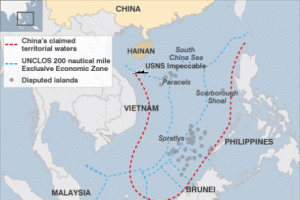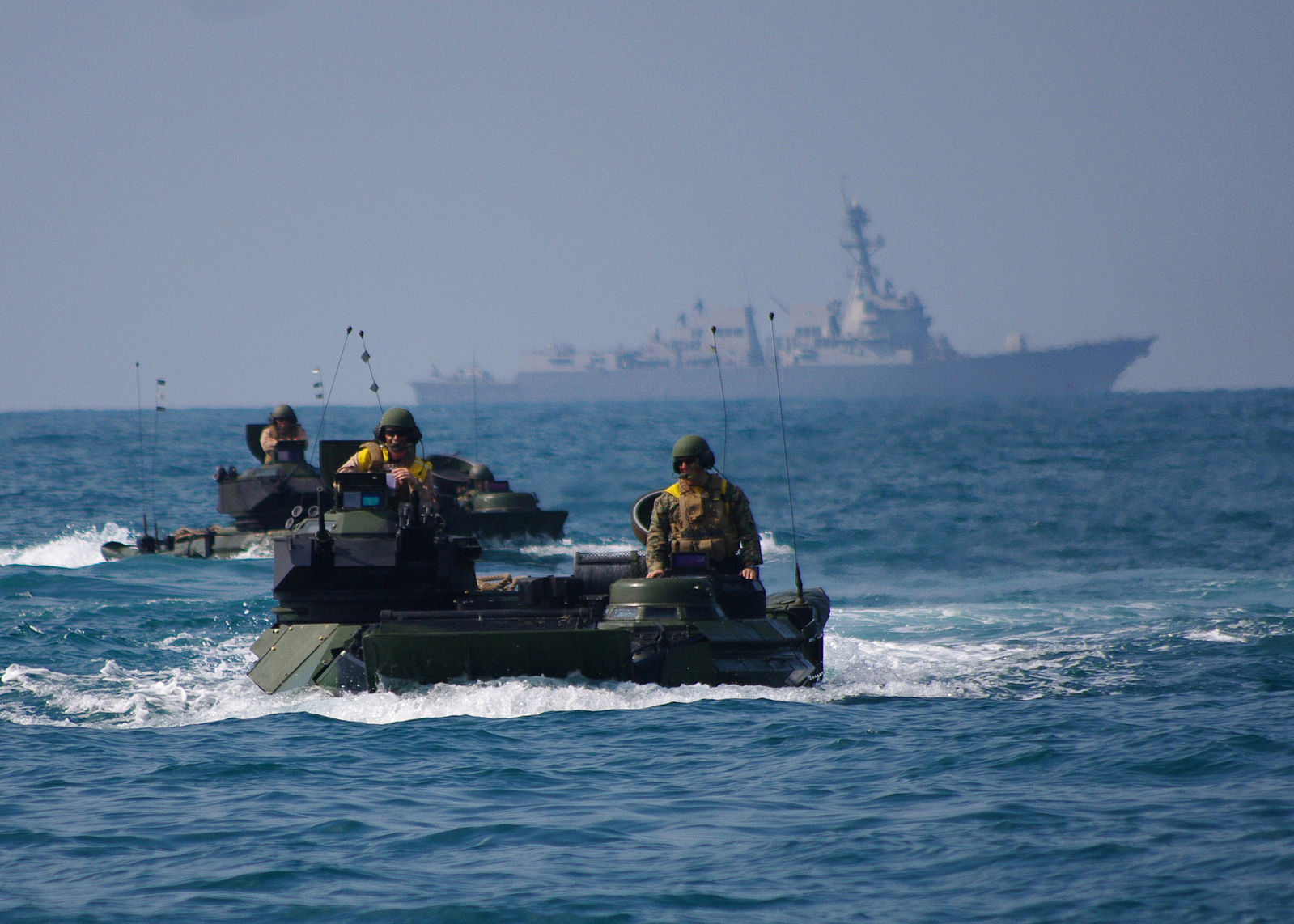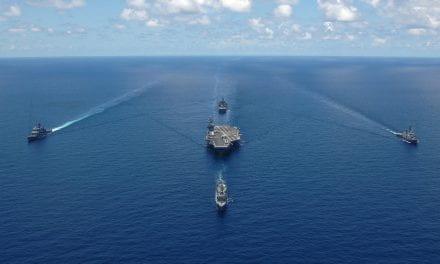By: Ruhley Michaelides*
The South China Sea lies between China, the Republic of Taiwan, Vietnam, Cambodia, Thailand, Malaysia, Brunei, the Philippines, and Indonesia. The aforementioned states are disputing China’s claim to territorial waters because it conflicts with their own claims to the same waters. Japan and the United States, which are extensive trading partners in the region, also oppose China’s claims. Furthermore, China is claiming territory over vast amounts of the sea which are international waters. A major international treaty has addressed claims to waters outside of a state’s territorial borders; however, international law has a difficult time constraining powerful states that are very self-interested. Chinese exceptionalism, combined with its history of unilateral actions, hinders the possibility that borders will return to the status quo in the region.
The third United Nations Convention on the Law of the Sea (UNCLOS) specifically outlines how coastal states may lay claim to and regulate bordering waters. The first twelve nautical miles from a state’s baseline border are “territorial waters” and the next twelve nautical miles are “contiguous waters.” States have virtually full jurisdiction in these areas (UN 1982 Part 2). The first two-hundred nautical miles are considered “exclusive economic zones” (EEZs) and provide states sole exploitation rights of natural resources, like fish and oil. Additionally, states may regulate the freedom of navigation and overflight in EEZs (UN 1982 Part 3). Every state bordering the SouthChina Sea is a party to UNCLOS (except for Thailand which is only a signatory). Nevertheless, China is asserting that its EEZs extend into what is supposed to be under international law, other states’ EEZs.
Territorial conflicts amongst the states encircling the sea have a long history; moreover, the past fifty years show that the exchange of gunfire is not rare in the region. Yet, today China is not just disputing territory, it is creating territory as well. Starting with the Mischief Reef in April of 2015, dredgers displacing sediment from the bottom of the sea onto reefs are artificially creating islands. The Chinese then use their claimed islands — artificially created or not — which are nearly in the center of the sea, to establish EEZs. China’s newly asserted EEZs both absorb what used to be international waters and directly overlap with other states’ waters. Unsurprisingly, China’s claims have provoked conflict. If China manages to maintain its claims then it will effectively have arbitrary control over passage in more than half of the sea, jeopardizing trade routes and resource exploitation in what would be international or state waters. Although an international tribunal in The Hague, Netherlands, has ruled China’s claimed EEZs as illegitimate, China has disavowed the rulings (Perlez, 2016).

While the international legality of China’s actions is, at best, arguable, one must consider the “ought” from the “is.” China is not afraid to be aggressive, currently building its second air craft carrier, signaling its intent for naval dominance (Stratfor, 2016). Since the United States is currently refusing to boldly intervene, the other states situated around the South China Sea will either have to act multilaterally, seek assistance from another great power, or accept the hegemon. Perhaps the United States has not taken a strong enough stance to deter China because the United States has not ratified UNCLOS, and therefore does not have the reciprocity grounds against which to hold China accountable. Additionally, Obama’s foreign policy platform has been run on a vigorously anti-war platform, further restraining the United States from taking a bold stance.
Regardless of the decision by other great powers, the regional states should adopt a strong policy of deterrence against expanding China. Chinese exceptionalism is the Sino-centric idea that emphasizes the beneficial uniqueness of Chinese culture while ignoring the pitfalls, supporting the advancement of Chinese culture over others in a seemingly logical way to the Chinese population. Chinese exceptionalism has and will continue to promote unilateral and imperialistic behavior; diplomacy will not solve the dispute without allowing China to expand its territorial waters. The regional states should create a multilateral military coalition to firmly oppose Chinese intrusion. The United States should be a part of that coalition, even if just supplying aid and intelligence, to avoid the appearance of a pro-war foreign policy. China has likely taken advantage of Obama’s anti-war platform to expand its influence as far as possible. While war should be an option of last resort, it is apparent that international rulings and military drills are not enough to constrain China. Still, the United States’s trade interests and key allies — specifically the Philippines — in the region must be secured. The next step should be a multilateral military coalition to deter the hegemon from impeding on state sovereignty.
While many may denounce a militarized response, it is the only logical response to restrain China. The Philippines and Vietnam are already emphatically calling for a firm international stance against China, while Japan, India, and Australia are steadily working to mitigate Chinese influence in the sea. China will not halt expansion until it is met at a standoff with other regional states — this standoff is likely to occur with or without the United States. However, it is in the best interests of the United States to keep sea out of China’s jurisdiction, protecting trade routes, minimizing the growing state’s power, and appealing to allies in the region. The coalition would deter war more than it would promote it, even more so if the United States joined such a coalition.
Works Cited
Perlez, Jane. 2016. “Tribunal Rejects Beijing’s Claims in South China Sea.” July 12. http://www.nytimes.com/2016/07/13/world/asia/south-china-sea-hague-ruling-philippines.html (Sept. 15).
Stratfor Enterprises. 2016. “A Look at Progress on a Chinese Aircraft Carrier.” June 3. https://www.stratfor.com/analysis/look-progress-chinese-aircraft-carrier (Sept. 16)
United Nations. 1982. “United Nations Convention on the Law of the Sea.” http://www.un.org/depts/los/convention_agreements/texts/unclos/unclos_e.pdf (Sept. 15).
*Disclaimer: The content contained in the following material is the sole ownership of the author and does not reflect the views of the Towson University Journal of International Affairs nor Towson University in any respect whatsoever






Ruhley Michaelides is correct, the United States’ trade interests and key allies in Asia must be secured. I disagree, however, that the next only logical response is a multilateral military coalition. A military response is more likely to increase the risk of conflict, rather than deter it. An economic response represents a better way to constrain China’s push into the South China Sea. Economic pressure sends a message to China and America’s allies, while avoiding military conflict. In response to Chinese expansion, the U.S. should work with the other countries surrounding the South China Sea to limit the traffic going through the exclusive economic zone (EEZ) China is claiming as its own.
If U.S. action carries risk, why must the U.S. act at all? The U.S. must act because aside from creating a multilateral military coalition, or an economic response, the surrounding countries may choose to do nothing to stop China’s push into the South China Sea. Michael Auslin argues that, “proving to allies such as the Philippines and potential partners such as Vietnam or Malaysia that the U.S. is serious about upholding international law and preserving rules-based order that underpins Asian trade, is a crucial step to ensuring that China does not browbeat its neighbors into submission” (Auslin, 2015). If the countries surrounding the South China Sea do nothing, they submit to Chinese influence and Chinese regional hegemony. Doing nothing would prove to be unproductive for the surrounding countries and may have negative unforeseen long-term effects. Inaction would also threaten the U.S.’ relationship in Asia and its position globally.
Similarly, cutting off all trade to China would not be an effective or careful constraint to China’s push into the South China Sea. If the U.S. and others were to completely cut off trade, there is the possibility that China might seize the goods being travelling through its claimed EEZ. This would result in further turmoil.
Returning to the military option, Michaelides is wrong that a military confrontation is the only logical response. In this situation a military confrontation is not only unnecessary, but there is risk that any conflict could escalate. Furthermore, although there may be a long history of territorial conflicts amongst states over use of the sea, it is not justification for military action today. What is needed is a response that imposes costs on China while minimizing risk to the U.S. and others.
The logical choice is to put economic pressure on China by shifting trade relations. Although this decision represents more of a slow burn to constrain China’s claim on the EEZs, yet, it also represents the best chance for altering Chinese behavior. By threatening the economic wellbeing of China’s growing middle class, such a shift in trade would threaten Chinese political stability and the position of current members of the government. In doing so, the resulting economic effects would pressure the Chinese government to conform to the international law and back away from its claims.
The Philippines and Vietnam are already calling for an international stance against China (Santos, 2014). Japan, India, and Australia are working together to diminish Chinese influence (Schrank, 2015). It would be best if these countries and the U.S. work together as one to constrain Chinese influence by agreeing to trade in other places and reducing the amount of goods that goes through the South China Sea.
Putting economic pressure on China would be a better way to address the conflict. It avoids direct military confrontation, sends a message to China, all without further escalating the situation. An economic approach may seem like a softer form of containment, yet it threatens the Chinese leadership in a way military action would not. Although Chinese exceptionalism promotes unilateral behavior, the potential unrest caused by a shift in trade would force China to abide by international law and consider how foreign actions might affect domestic politics. An economic response allows China’s neighbors to accomplished their goal of constraining China’s push into the South China Sea while avoiding a multilateral military confrontation.
Works Cited
Auslin, Michael. 2015. “America vs. China: Showdown in the South China Sea.” November 12. http://nationalinterest.org/blog/the-buzz/america-vs-china- showdown-the-south-china-sea-14324
Santos, Matikas. 2014. “PH has backing of Vietnam, Malaysia vs. China’s sea claims.” March 6. http://globalnation.inquirer.net/99908/ph-has-backing-of-vietnam- malaysia-vs-chinas-sea-claims-says-binay
Schrank, Peter. 2015. “Come together on the Abe road.” December 12. http://www.economist.com/news/asia/21679756-leaders-india-and-japan-admire- each-other-and-fear-china-their-friendship-will-affect